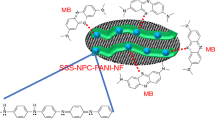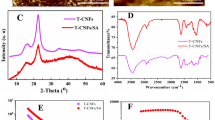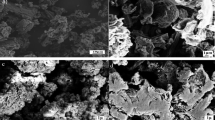Abstract
Porous and fibrous nanocomposite with granular surface morphology was prepared by coating of polyaniline onto carbonized tea waste material employing a low cost and facile method. The as-synthesized nanofiber adsorbent was characterized using FTIR, Ultraviolet-visible, Thermal gravimetric analysis, BET, FESEM, HRTEM, and zeta potential analysis. The adsorption capacity of the fabricated adsorbent was evaluated against the removal of rhodamine B (RhB) dye from aqueous samples, 34.9315 mg/g adsorption capacity, and 95.21% of removal efficiency was observed. The results show that the prepared nanoadsorbent has well-defined porous and fibrous structure with granular morphology, a small average diameter (3–90nm), high specific surface area (50.1296 m2 g−1), and pore volume (0.2054 cm3 g−1). The pore size distribution is ranged from 2 to 5nm. The adsorption kinetics is well described by a pseudo-second-order model, and the adsorption process is controlled jointly by the intra-particle diffusion and film diffusion process. The adsorption data were found to be well fitted with the Langmuir isotherm model. The thermodynamic study has revealed that the adsorption process is spontaneous, exothermic, and marked with the enhancement in randomness at the adsorbent–adsorbate interface. The positive value of ΔH° indicates that the physical forces are involved in the adsorption process. The polyaniline-coated tea waste carbon (PCTWC) nanocomposite has shown its high regeneration ability even after five consecutive cycles of adsorption-desorption.


















Similar content being viewed by others
Data availability
The datasets generated during and/or analyzed during the current study are available from the corresponding author on reasonable request.
References
Zhou Y, Lu J, Zhou Y, Liu Y (2019) Recent advances for dyes removal using novel adsorbents: a review. Environ Pollut 252:352–365. https://doi.org/10.1016/j.envpol.2019.05.072
Yadav S, Yadav A, Bagotia N, Sharma AK, Kumar S (2021) Adsorptive potential of modified plant-based adsorbents for sequestration of dyes and heavy metals from wastewater-a review. J Water Process Eng 42:102148
Castro-Munoz R (2020) The role of new inorganic materials in composite membranes for water disinfection. Membranes 10:101. https://doi.org/10.3390/membranes10050101
Castro-Munoz R (2020) Breakthroughs on tailoring pervaporation membranes for water desalination: a review. Water Res 187:116428. https://doi.org/10.1016/j.watres.2020.1164280
Castro-Munoz R, Barragan-Huerta BE, Fíla V, Denis PC, Ruby-Figueroa R (2018) Current role of membrane technology: from the treatment of agroindustrial by-products up to the valorization of valuable compounds. Waste Biomass Valorization 9:513–529. https://doi.org/10.1007/s12649-017-0003-1
Yadav A, Bagotia N, Sharma AK, Kumar S (2021) Simultaneous adsorptive removal of conventional and emerging contaminants in multicomponent systems for wastewater remediation: a critical review. Sci Total Environ 799:149500. https://doi.org/10.1016/j.scitotenv.2021.149500
Yadav A, Bagotia N, Yadav S, Sharma AK, Kumar S (2021) Adsorptive studies on the removal of dyes from single and binary systems using Saccharum munja plant-based novel functionalized CNT composites. Environ Technol Innov 24:102015. https://doi.org/10.1016/j.eti.2021.102015
Aruna Bagotia N, Sharma AK, Kumar S (2021) A review on modified sugarcane bagasse biosorbent for removal of dyes. Chemosphere 268:129309. https://doi.org/10.1016/j.chemosphere.2020.129309
Fadaei S, Noorisepehr M, Pourzamani H, Salari M, Moradnia M, Darvishmotevalli M et al (2021) Heterogeneous activation of peroxymonosulfate with Fe3O4 magnetic nanoparticles for degradation of Reactive Black 5: batch and column study. J Environ Chem Eng 9:4–105414
Dlamini ML, Bhaumik M, Pillay K, Maity A (2021) Polyaniline nanofibers, a nanostructured conducting polymer for the remediation of Methyl orange dye from aqueous solutions in fixed-bed column studies. Heliyon 7:e08180. https://doi.org/10.1016/j.heliyon.2021.e08180
Ardila-Leal LD, Poutou-Pinales RA, Pedroza-Rodríguez AM, Quevedo-Hidalgo BE (2021) A brief history of colour, the environmental impact of synthetic dyes and removal by using laccases. Molecules 26:3813
Pan X, Gu Z, Chen W, Li Q (2021) Preparation of biochar and biochar composites and their application in a Fenton-like process for wastewater decontamination: a review. Sci Total Environ 754:142104. https://doi.org/10.1016/j.scitotenv.2020.142104
Mittal J, Ahmad R, Mariyam A, Gupta VK, Mittal A (2021) Expeditious and enhanced sequestration of heavy metal ions from aqueous environment by papaya peel carbon: a green and low cost adsorbent. Desalin Water Treat 210:365–376. https://doi.org/10.5004/dwt.2021.26562
Singh NH, Kezo K, Debnath A, Saha B (2018) Enhanced adsorption performance of a novel Fe-Mn-Zr metal oxide nanocomposite adsorbent for anionic dyes from binary dye mix: response surface optimization and neural network modeling. Appl Organomet Chem 32:4165
Deb A, Kanmani M, Debnath A, Bhowmik KL, Saha B (2018) Ultrasonic assisted enhanced adsorption of methyl orange dye onto polyaniline impregnated zinc oxide nanoparticles: kinetic, isotherm and optimization of process parameters. Ultrasonics-Sonochemistry 54:290–301
Zare EN, Motahari A, Sillanpaa M (2018) Nanoadsorbents based on conducting polymer nanocomposites with main focus on polyaniline and its derivatives for removal of heavy metal ions/dyes: a review. Environ Res 162:173–195. https://doi.org/10.1016/j.envres.2017.12.025
Yadav A, Bagotia N, Sharma AK, Kumar S (2021) Advances in decontamination of wastewater using biomass-based composites: a critical review. Sci Total Environ 784:147108. https://doi.org/10.1016/j.scitotenv.2021.147108
Guzel F, Saygili H, Saygili GA, Koyuncu F (2014) Elimination of anionic dye by using nanoporous carbon prepared from an industrial biowaste. J Mol Liquids 194:130–140
Lafi R, Hafiane A (2016) Removal of methyl orange (MO) from aqueous solution using cationic surfactants modified coffee waste (MCWs). J Taiwan Inst Chem Eng 58:424–433
Savci S, Uysal MM (2017) Adsorption of methylene blue and methyl orange by using waste ash. Süleyman Demirel Üniv Fen Bilim Enstitüsü Derg 21:831
Saravanan P, Josephraj J, Thillainayagam BP, Ravindiran G (2021) Evaluation of the adsorptive removal of cationic dyes by greening biochar derived from agricultural bio-waste of rice husk. Biomass Convers Biorefinery. https://doi.org/10.1007/s13399-021-01415-y
Luo L, Wu X, Li Z, Zhou Y, Chen T, Fan M, Zhao W (2019) Synthesis of activated carbon from biowaste of fir bark for methylene blue removal. R Soc Open Sci 6:190523. https://doi.org/10.1098/rsos.190523
Zhao W, Luo L, Chen T, Li Z, Zhang Z, Fan M (2018) Activated carbons from oil palm shell for hydrogen storage. Mater Sci Eng 368:012031. https://doi.org/10.1088/1757-899X/368/1/012031
Okman I, Selhan K, Tay T, Erdem M (2014) Activated carbons from grape seeds by chemical activation with potassium carbonate and potassium hydroxide. Appl Surf Sci 293:138–142. https://doi.org/10.1016/j.apsusc.2013.12.117
Zhao W, Luo Lu, Wang H, Fan M (2017) Synthesis of bamboo-based activated carbons with super-high specific surface area for hydrogen storage. Bioresources 12:1246–1262. https://doi.org/10.15376/biores.12.1.1246-1262
Xin Q, Fu J, Chen Z, Liu S, Yan Y, Zhang J, Xu Q (2015) Polypyrrole nanofibers as a high-efficient adsorbent for the removal of methyl orange from aqueous solution. J Environ Chem Eng 3:1637–1647
Li S, Jia Z, Li Z, Li Y, Zhu R (2016) Synthesis and characterization of mesoporous carbon nanofibers and its adsorption for dye in wastewater. Adv Powder Technol 27:591–598. https://doi.org/10.1016/j.apt.2016.01.024
Ding X, Han D, Wang Z, Xu X, Niu L, Zhang Q (2008) Micelle-assisted synthesis of polyaniline magnetite nanorods by in situ self–assembly process. J Colloid Interface Sci 320:341–345
Taghizadeh A, Taghizadeh M, Jouyandeh M, Yazdi MK, Zarrintaj P, Saeb MR, Lima EC, Gupta VK (2020) Conductive polymers in water treatment: a review. J Mol Liq 312:113447
Stejskal J (2020) Interaction of conducting polymers, polyaniline and polypyrrole, with organic dyes: polymer morphology control, dye adsorption and photocatalytic decomposition. Chem Pap 74:1–54
Minisy IM, Salahuddin NA, Ayad MM (2018) Chitosan/polyaniline hybrid for the removal of cationic and anionic dyes from aqueous solutions. J Appl Polym Sci. https://doi.org/10.1002/APP.47056
Duhan M, Kaur R (2019) Adsorptive removal of methyl orange with polyaniline nanofibers: an unconventional adsorbent for water treatment. Environ Technol. https://doi.org/10.1080/09593330.2019.1593511
Salem MA, Elsharkawy RG, Hablas MF (2015) Adsorption of Brilliant Green dye by polyaniline/silver nanocomposite: kinetic, equilibrium, and thermodynamic studies. Eur Polym J. https://doi.org/10.1016/j.eurpolymj.2015.12.027
Saad M, Tahir H, Khan J, Hameed U, Saud A (2017) Synthesis of polyaniline nanoparticles and their application for the removal of Crystal Violet dye by ultrasonicated adsorption process based on response surface methodology. Ultrason Sonochem 34:600–608
Sun C, Xiong B, Pan Y, Cui H (2017) Adsorption removal of tannic acid from aqueous solution by polyaniline: analysis of operating parameters and mechanism. J Colloid Interface Sci 487:175–181
Yan B, Chen Z, Cai L, Chen Z, Fu J, Xu Q (2015) Fabrication of polyaniline hydrogel: synthesis, characterization and adsorption of methylene blue. Appl Surf Sci 356:39–47
Bhaumik M, McCrindle RI, Maity A, Agarwal S, Gupta VK (2016) Polyaniline nanofibers as highly effective re-usable adsorbent for removal of reactive black 5 from aqueous solutions. J Colloid Interface Sci 466:442–451
Zheng Y, Wang W, Huang D, Wang A (2012) Kapok fiber oriented-polyaniline nanofiber for efficient Cr(VI) removal. Chem Eng J 191:154–161
El-Sharkaway EA, Kamel RM, El-Sherbiny IM (2019) Gharib SS (2019) Removal of methylene blue from aqueous solutions using polyaniline/grapheme oxide or polyaniline/reduced graphene oxide composites. Environ Technol. https://doi.org/10.1080/09593330.2019.1585481
Yavuz AG, Dincturk-Atalay E, Uygun A, Gode F, Aslan E (2011) A comparison study of adsorption of Cr (VI) from aqueous solutions onto alkyl-substituted polyaniline/chitosan composites. Desalination 279:325–331
Mansour MS, Ossman ME, Farag HA (2011) Removal of Cd (II) ion from waste water by adsorption onto polyaniline coated on sawdust. Desalination 272:301–305
Tamilarasan P, Ramaprabhu S (2012) Polyaniline–magnetite nanocapsules based nanocomposite for carbon dioxide adsorption. Int J Greenhouse Gas Control 10:486–493
Kumar PA, Chakraborty S, Ray M (2008) Removal and recovery of chromium from wastewater using short chain polyaniline synthesized on jute fiber. Chem Eng J 141:130–140
Arulkumar M, Thirumalai K, Sathishkumar P, Palvannan T (2012) Rapid removal of chromium from aqueous solution using novel prawn shell activated carbon. Chem Eng J 185:178–186
Qiu B, Xu C, Sun D, Wei H, Zhang X, Guo J, Wang Q, Rutman D, Guo Z, Wei S (2014) Polyaniline coating on carbon fiber fabrics for improved hexavalent chromium removal. RSC Adv 4:29855. https://doi.org/10.1039/c4ra01700e
Khalili S, Khoshandam B, Jahanshahi M (2016) Synthesis of activated carbon/polyaniline nanocomposites for enhanced CO2 adsorption. RSC Adv 6:35692. https://doi.org/10.1039/c6ra00884d
Budi S, Yusmaniar Rahmadi F, Maryanti Muhab S (2020) The high capacitance and surface area of a polyaniline/polypyrrole composite. J Chem Technol Metall 55(1):28–33
Wong S, Ghafar NG, Ngadi N, Razmi FA, Inuwa IM, Ramli Mat R, Amin NAS (2020) Effective removal of anionic textile dyes using adsorbent synthesized from coffee waste. Sci Rep 10:2928. https://doi.org/10.1038/s41598-020-60021-6
Jun LY, Mubarak NM, Yon LS, Bing CH, Khalid M, Abdullah EC (2018) Comparative study of acid functionization of carbon nanotube via ultrasonic and reflux mechanism. J Environ Chem Eng 6:5889–5896. https://doi.org/10.1016/j.jece.2018.09.008
Yadav Aruna, Bagotia N, Yadav S, Asharma AK, Kumar S, Aruna Bagotia N, Sharma AK, Kumar S (2021) Adsorptive studies on the removal of dyes from single and binary systems using Saccharum munja plant-based novel functionalized CNT composites. Environ Technol Innov 24:102015
Sharma AK, Sharma Yashpal (2012) Pseudo capacitive studies of polyaniline-carbon nanotube composites as electrode material for supercapacitor. Anal Lett 45(14):2075–2085. https://doi.org/10.1080/00032719.2012.680057
Sharma AK, Sharm Y (2013) p-toluene sulfonic acid doped polyaniline carbon nanotube com-posites: synthesis via different routes and modified properties. J Electrochem Sci Eng 3(2):47–56. https://doi.org/10.5599/jese.2013.0029
Sindhimeshram DC, Gupta MC (1995) Transport properties of substituted derivatives of polyaniline. Indian J Chem 34A:260–277
Akbar SA, Satria E (2019) UV-Vis study on polyaniline degradation at different pH and the potential application for acid-base indicator. Rasayan J Chem 12(3):1212–1218. https://doi.org/10.31788/RJC.2019.1235370
Li Y, Zhao X, Xu Q, Zhang Q, Chen D (2011) Facile preparation and enhanced capacitance of the polyaniline/sodium alginate nanofiber network for supercapacitors. Langmuir 27:6458–6463
Wang L, Liu X, Wang Yang XX, Lu L (2010) Preparation and electrochemical properties of mesoporous Co3O4 crater-like microspheres as supercapacitor electrode materials. Curr Appl Phys 10:1422–1426
Basturk E, Cakmakci E, Madakbas S, Kahraman MV (2018) Surface and proton conductivity properties of electrospun poly(vinyl butyral)/polyaniline nanofibers. Adv Polym Technol 37:1774–1781
Bandgar DK, Khuspe GD, Pawar RC, Lee CS, Patil VB (2014) Facile and novel route for preparation of nanostructured polyaniline (PANi) thin films. Appl Nanosci 4:27–36. https://doi.org/10.1007/s13204-012-0175-8
Mousavi SA, Kamarehie B, Almasi A, Darvishmotevalli M, Salari M, Moradnia M, Azimi F, Ghaderpoori M, Neyazi Z, Karami MA (2021) Rhodamine B from aqueous solution by stalk corn activated carbon: adsorption and kinetic study. Biomass Convers Biorefinery. https://doi.org/10.1007/s13399-021-01628-1
Pittman JL, Schrum KF, Gilman SD (2001) On-line monitoring of electroosmotic flow for capillary electrophoretic separations. Analyst 126:1240–1247
Gupta VK, Mohan D, Sharma S, Sharma M (2000) Removal of basic dyes (rhodamine B and methylene Blue) from aqueous solutions using bagasse fly ash. Sep Sci Technol 35:2097–2113
Mahto TK, Chowdhuri AR, Sahu SK (2014) Polyaniline-functionalized magnetic nanoparticles for the removal of toxic dye from wastewater. J Appl Polym Sci. https://doi.org/10.1002/APP.40840
Gad MHH, El-Sayed AA (2009) Activated carbon from agricultural by-products for the removal of rhodamine-B from aqueous solution. J Hazard Mater 168:1070–1081
Lagergren S (1898) About the theory of so-called adsorption of soluble substances. Kungliga Svenska Vetenskapsakademiens Handlingar 24:1–39
Ho YS, McKay G (1999) Pseudo-second order model for sorption processes. Process Biochem 34:451–465
Zeldowitsch J (1934) Uber denmechanismus der katalytischenoxydation von CO a MnO2. URSS, Acta Physiochim 1(2):364–449
Weber WJ, Morris JC (1936) Kinetics of adsorption on carbon from solutions. J Sanit Eng Div 89:31–60
Boyd GE, Adamson AM, Myers LS (1949) The exchange adsorption of ions from aqueous solutions by organic zeolites. II. Kinetics. J Am Chem Soc 69:2836–2848
Mezenner NY, Bensmaili A (2009) Kinetics and thermodynamic study of phosphate adsorption on iron hydroxide-eggshell waste. Chem Eng J 147:87–96
Kajjumba GW, Emik S, Ongen A, KurtulusOzcan H, Aydın S (2018) Modelling of adsorption kinetic processes—errors. Theory Applic. https://doi.org/10.5772/intechopen.80495
Mane VS, Mall ID, Shrivastava VC (2007) Kinetic and equilibrium isotherm studies for the adsorptive removal of brilliant green dye from aqueous solution by rice husk ash. J Environ Manage 84:390–400
Salam MA (2013) Removal of heavy metal ions from aqueous solutions with multi-walled carbon nanotubes: kinetic and thermodynamic studies. Int J Environ Sci Technol 10:677–68
Langmuir I (1916) The constitution and fundamental properties of solids and liquids. J Am Chem Soc 38:2221–2295. https://doi.org/10.1021/ja02268a002
Freundlich HZ (1906) Uber die adsorption in losungen. Z Phys Chem 57:385–470
Temkin MJ, Pyzhev V (1940) Recent modifications to Langmuir isotherms. Acta Physicochim URSS 12:217–225
Dubinin MM, Zaverina ED, Radushkevich LV (1947) Sorption and structure of active carbons. I. Adsorption of organic vapors. Zh Fiz Khim 21:1351–1362
Shahwan T, Erten HN (2004) Temperature effects on barium sorption on natural kalinite and chlorite-illite clays. J Radioanal Nucl Chem 260:43–48
Hutson ND, Yang RT (1997) Theoretical basis for the Dubinin-Radushkevitch (D–R) adsorption isotherm equation. Adsorption 3:189–195
Khan TA, Chaudhry SA, Ali I (2015) Equilibrium uptake, isotherm and kinetic studies of Cd(II) adsorption onto iron oxide activated red mud from aqueous solution. J Mol Liq 202:165–175
Wang C, Liu J, Zhang Z, Wang B, Sun H (2012) Adsorption of Cd(II), Ni(II), and Zn(II) by tourmaline at acidic conditions: kinetics, thermodynamics and mechanisms. Ind Eng Chem Res 51:4397–4406
Lu X, Shi D, Chen J (2017) Sorption of Cu2+ and Co2+ using zeolite synthesized from coal gangue: isotherm and kinetic studies. Environ Earth Sci 76:591. https://doi.org/10.1007/s12665-017-6923-z
Li J, Hu M-Z (2011) Removal of rhodamine B from aqueous solutions by tea waste, IEEE, 1375-1378.
Khan TA, Nazir M, Khan EA (2013) Adsorptive removal of rhodamine B from textile wastewater using water chestnut (Trapa natans L.) peel: adsorption dynamics and kinetic studies. Toxicol Environ Chem 95(6):919–931. https://doi.org/10.1080/02772248.2013.840369
Dhanavel S, Nivethaa EAK, Dhanapal K, Gupta VK, Narayanan V, Stephen A (2016) α-MoO3/Polyaniline composite for effective scavenging of Rhodamine B, Congo red and textile dye effluent. RSC Adv https://doi.org/10.1039/C6RA02576E
Hayeeye F, Sattar M, Chinp W, Sirichote O (2017) Kinetics and thermodynamics of Rhodamine B adsorption by gelatin/activated carbon composite beads. Colloids Surf A 513:259–266
Ptaszkowska-Koniarz M, Goscianska J, Pietrzak R (2018) Removal of rhodamine B from water by modified carbon xerogels. Colloids Surf A 543:109–117
Cheng Z-L, Li Y-X, Liu Z (2018) Study on adsorption of rhodamine B onto Beta zeolites by tuning SiO2/Al2O3 ratio. Ecotoxicol Environ Saf 148:585–592
Singh NB, Agarwal A, Rachna KM (2020) Adsorptive and photocatalytic removal of rhodamine B Dye from water by using copper ferrite polyaniline nanocomposite. J Sci Ind Res 79:558–561
Maqbool M, Bhatti HN, Sadaf S, Zahid M, Shahid M (2019) A robust approach towards green synthesis of polyaniline-Scenedesmus biocomposite for wastewater treatment applications. Mater Res Express 6:055308
Ayad MM, El-Nasr AA, Stejska J (2012) Kinetics and isotherm studies of methylene blue adsorption onto polyaniline nanotubes base/silica composite. J Ind Eng Chem 18:1964–1969
Xia Y, Li T, Chen J, Cai C (2013) Polyaniline (skin)/polyamide 6 (core) composite fiber: preparation, characterization and application as a dye adsorbent. Synth Met 175:163–169
Shen J, Shahid S, Amura I, Sarihana A, Tian M, Emanuelsson EAC (2018) Enhanced adsorption of cationic and anionic dyes from aqueous solutions by polyacid doped polyaniline. Synth Met 245:151–159. https://doi.org/10.1016/j.synthmet.2018.08.015
Acknowledgments
The authors are thankful to MRC, MINT (Jaipur), CAF, Manipal University (Jaipur), and Department of Chemistry, University of Rajasthan, Jaipur (India), for providing research facilities and supporting us. J.K.S. thanks the CSIR-India and K.P. thanks the UGC-India for their fellowships.
Author information
Authors and Affiliations
Contributions
All authors contributed to the study conception and design. Material preparation, data collection, and analysis were performed by Parmeshwar Lal Meena, Jitendra Kumar Saini, Krishna Poswal, Aajy Kumar Surela, and Lata Kumar Chhachhia. The first draft of the manuscript was written by Jitendra Kumar Saini, and all authors commented on previous versions of the manuscript. All authors read and approved the final manuscript.
Corresponding author
Ethics declarations
Conflict of interest
The authors declare no competing interests.
Additional information
Publisher's Note
Springer Nature remains neutral with regard to jurisdictional claims in published maps and institutional affiliations.
Supplementary Information
Below is the link to the electronic supplementary material.
Rights and permissions
About this article
Cite this article
Meena, P.L., Saini, J.K., Surela, A.K. et al. Fabrication of polyaniline-coated porous and fibrous nanocomposite with granular morphology using tea waste carbon for effective removal of rhodamine B dye from water samples. Biomass Conv. Bioref. 14, 1711–1730 (2024). https://doi.org/10.1007/s13399-021-02267-2
Received:
Revised:
Accepted:
Published:
Issue Date:
DOI: https://doi.org/10.1007/s13399-021-02267-2




